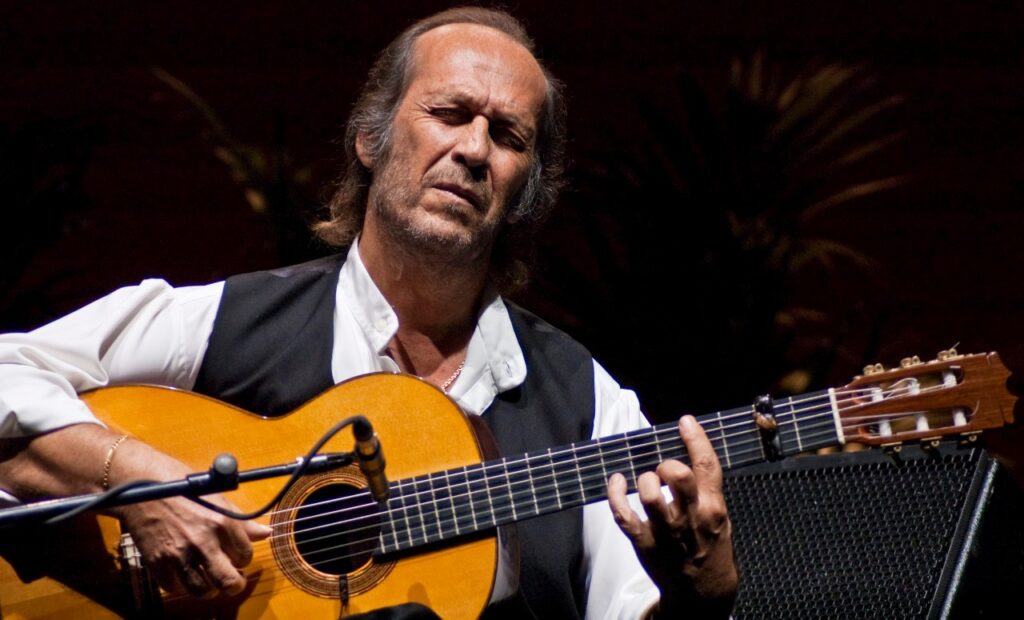Artists
Paco De Lucia Biography
Perhaps the most universal flamenco artist, Paco De Lucía was born on December 17, 1947, in Algeciras (Cádiz), a port city in Spain’s southern Andalusia region, as the son of Gypsy flamenco guitarist Antonio Sánchez.
Paco De Lucia was subjected to hard work from a very young age by his father.
In 1958, he made his first performance on Radio Algeciras, a local radio, accompanying the songs sung by his brother Pepe. The following year he won a prestigious guitar competition at Jerez de la Frontera and made his first recording in 1961.
“My father and all my brothers were playing the guitar. So before I started to speak, I took the guitar in my hand, I was listening to the guitar all the time. Before I started playing the guitar, I knew all the flamenco rhythms, I knew the feel and meaning of the music. Therefore, when I started playing, I started playing directly by ear.”
At the age of 13 he started working in the dance company of José Greco. Despite his young age, thanks to his outstanding performance, he went to different countries with the dance troupe and participated in concerts.
In the late 60s and early 70s Paco de Lucía was known around the world. He started playing in his own style after the first scene with Ninó Ricardo accompanying him and the second scene where he discovers Sabicas, Mario Escudero and others.
In 1967 he released his first solo album, “La Fabulosa Guitarra de Paco de Lucia”. He reflected his style with his second solo album “Fantasia Flamenca” in 1968.
In the early 1970s, he met his close friend Camaron de la Isla, with whom he would later collaborate for a total of 10 albums. In the same year, he appeared on the famous Carnegie Hall stage. He attracted international attention with the song “El Duende Flamenco” in 1972 and “Entre Dos Aguas”, which was included in the album “Fuente y Caudal” the following year.
In 1975, the artist, who gave a concert at the Madrid Royal Theatre, whose name made history, continued on his path by breaking new ground with the album “Almoraima”, which he released a year later.
In 1977, they ended their musical work with Camaron when Paco de Lucia turned to more solo concerts and artistic activities. After 1977, Camaron continued his studies with Tomatito, a student of Paco de Lucia.
Paco De Lucía, who became interested in jazz fusion since the late 1970s, did not give up trying new things even though he received the reaction of classical flamenco players with the style reflected in Al Di Meola’s 1977 album “Elegant Gypsy”.
His interest in innovation drove him to constantly try new things, to combine flamenco and different styles in his music…
His approaches to other musical styles are notable for not only enriching his art but also for having decisive influences on modern flamenco. Paco De Lucia says that he will never lose his flamenco identity, on the contrary, he draws his strength from it.
Paco de Lucia says that, unlike classical flamenco players, working with different music genres does not weaken the flamenco identity, on the contrary, it strengthens it.
In another interview, he says: “It is undoubtedly flamenco that drives my style, I wouldn’t be me if it wasn’t for flamenco.”
In 1979, De Lucía formed the Guitar Trio with John McLaughlin and Larry Coryell, and they went on a short European tour to record a video called Spirits Meeting at the Royal Albert Hall in London. Later, Al Di Meola replaced Coryell. Beginning in 1981, this trio recorded three albums. Paco de Lucía’s own band, Paco de Lucía Sextet, which also included his brothers Ramón and Pepe, also released the first of their three albums in the same year.
Paco De Lucía has released several albums on his own in traditional and modern flamenco styles. He created a new understanding of flamenco with his wide repertoire, transcending the technical and musical limits of the guitar. On March 23, 2007, the University of Cadiz rewarded Paco de Lucía’s musical and cultural contributions by awarding him an honorary doctorate (Doctor Honoris Causa).
De Lucía is considered a master of rasgueado and picado, he can use the classical guitar extremely quickly.
de Lucía did not know how to read musical notes until she was asked to interpret Joaquín Rodrigo’s Concierto de Aranjuez in 1991. De Lucía later stated that when interpreting the Concierto he placed emphasis on rhythmic accuracy, compromising the tonal fidelity that classical guitarists value.
Paco de Lucía died on February 25, 2014, at the age of 66, as a result of a heart attack while playing on the beach with his children.
